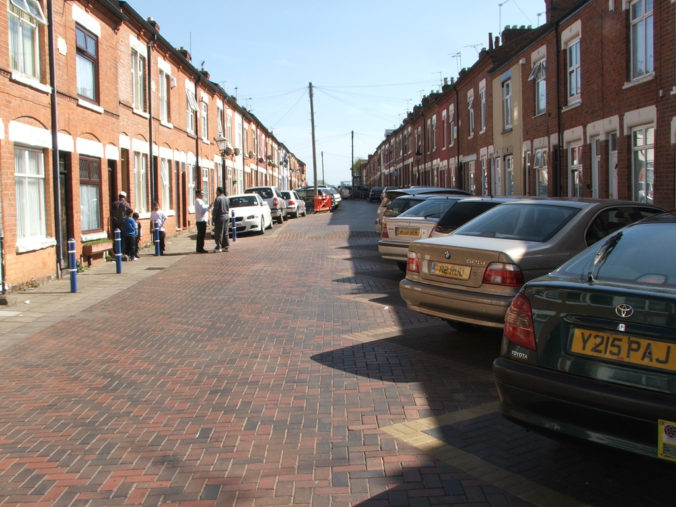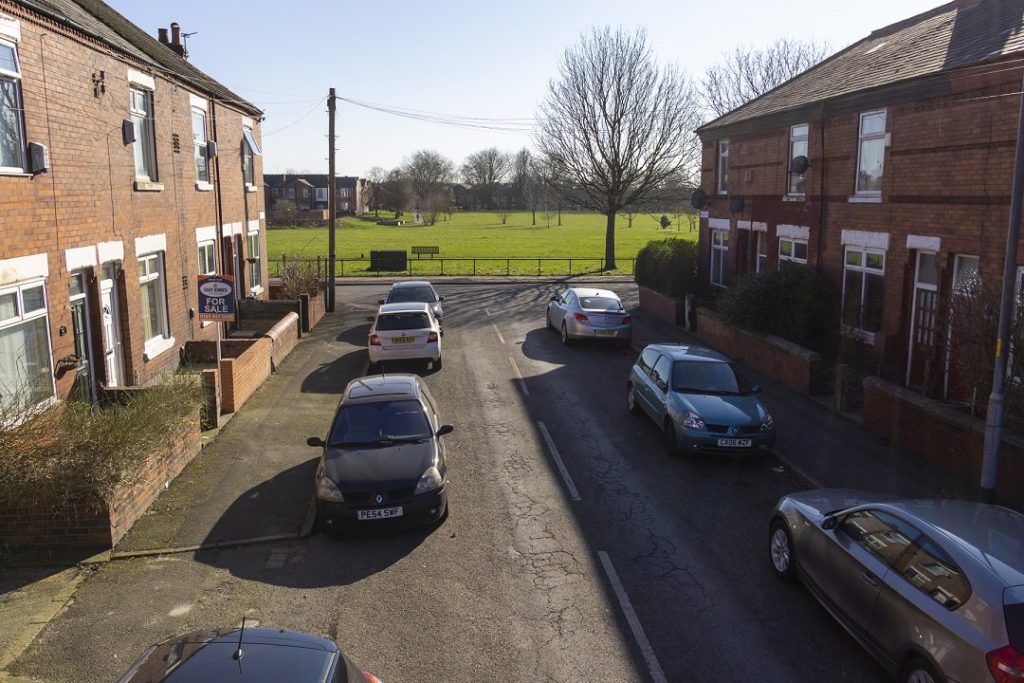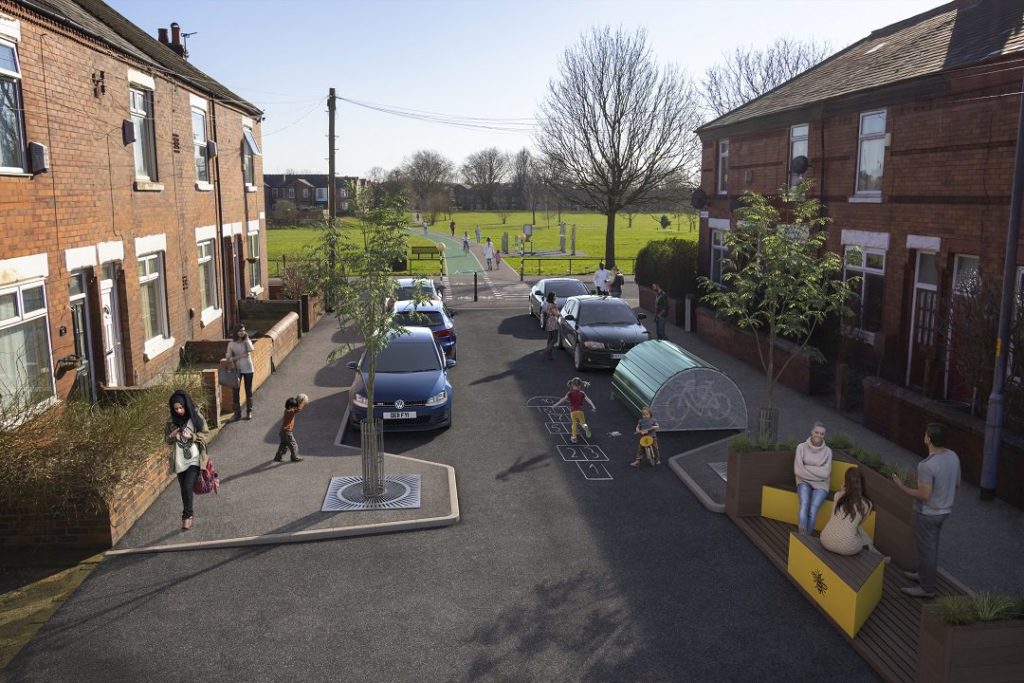Statement from The Strathbungo Society Committee
Traffic and parking in Strathbungo present a problem of ever increasing severity; recently we have been informally advised that it will soon be necessary to restrict parking in Regent Park, Queen and Marywood Squares to a single side in order to allow access for emergency vehicles. Fire vehicles in particular are increasingly unable to get along these streets. There is however an alternative more radical solution to this problem that will also take care of many of the other environmental problems associated with Strathbungo’s streets. It is clearly not practicable to think of restricting use of the streets to pedestrians alone (pedestrian precinct) but it is possible to consider a residential precinct. This type of arrangement has been extensively used in Holland where it is known as a Woonerf (plural Woonerven).
A Woonerf is a residential area in which traffic is not allowed to dominate and in which this fact is emphasised by the use of a special layout which physically restricts moving traffic speeds particularly by the use of attractive street furniture. In a Woonerf pedestrians and traffic share the same street area, there are no pavements and no separate road surface; drivers are required to ensure the safety of pedestrians, and must expect that children will be playing on the street. In a typical Woonerf the parking space available is usually about half that of the conventional street layout. (In Strathbungo this would mean that extensive use will have to be made of back garden parking.) Dutch experience has shown that the amount of traffic flowing through a Woonerf must be restricted to that having destinations in the area only – through traffic must be excluded. (In Strathbungo this would require that Moray Place be at least blocked at Nithsdale Road). It is of course necessary to demonstrate by the use of signs that motor vehicles are entering a Woonerf so that drivers will know that vehicle speeds must be restricted to about walking pace. Parking areas in a Woonerf are physically defined by a change of street surface (eg. colour or finish) and by the use of small P symbols set in the surface. Parking areas are also laid out by the arrangement of the street furniture (lamp standards, plant tubs etc) which is also used to introduce ‘dog legs’ which will keep down traffic speed. The street furniture is also used to ensure that moving vehicles cannot pass directly in front of garden gates. [Because of the necessity to confine moving traffic, streets in a Woonerf must be one-way only. In Strathbungo use of the Woonerf principle would therefore also require the introduction of a traffic management scheme.]
Representatives of the Strathbungo Society were recently invited to a meeting with the Roads Department at which it was revealed that the Department was studying the possibility of creating a residential precinct which would eventually extend throughout Strathbungo. The committee of the Strathbungo Society is of the opinion that every encouragement should be given to the Roads Department to work out their proposals in full and has invited a representative of the Department to attend the A.G.M. of the Society, when there will be an opportunity for members to see slides of Dutch Woonerven and look at plans providing details of typical street layouts in Woonerven.
Comments?
So, what do you think? Could this work? Comments welcome.
A footnote
What we forgot to mention when this was first published was that we lifted it word for word from the Strathbungo Society newsletter.
Of 1979. That’s forty years ago.
Since then the number of cars has increased over 200% (more on that later) and they have taken over the pavements too. The only place to walk in some streets is in the road, and it doesn’t feel safe. Is that progress?
Woonerf in Manchester
Before and after images of one of the approved plans for improving walking and cycling in Manchester.










 #b
#b














Don’t agree with this. We live in a built up commercial area full of restaurants and bars. As well as a direct bus and train route to city centre Every weekend it’s chaotic trying to park as a resident as the area has visitors to the restaurants etc. And each weekday morning travellers use the spaces then hop on the bus/train. They did this type of thing in Partick and my friends have to park far from home at night and walk due to lack of space
I have generally been of the opinion most cars in Strathbungo belong to residents (may be different in Nithsdale Road though). If that isn’t the case, would you support a residential parking scheme for instance? No such thing has been proposed by the way, just exploring ideas.
When we lived in the Strathbungo bit of Nithsdale Road, there was definitely a fair amount of commuter parking. I agree there’s not much in the Squares/Gardens, however.
Something has to change and this looks like a reasonable alternative to what we have now. Of course emergency vehicles should have proper access and I’m sick of collecting damage to paintwork while parked despite parking as considerately as I can myself. There would have to be accommodation of offloading needs and disability parking as many of us who have lane parking space do not have immediate access to that space. The state of the lanes is another, but related issue.
About 18 years ago, we had a house fire in RPS, and because of cars parked across corners & lane entrances, it took the Fire Service 25mins to get to our house. In consequence, the amount of damage was extensive; if anyone had been trapped inside, the fire brigade might have been too late.
Our children’s lives would be improved in so many ways if we got rid of most cars : they could play outside, they could cycle to school, the air would be cleaner, the streets would be safer.
Also, our planet faces the imminent prospect of runaway climate change if we don’t drastically reduce consumption of oil. Reducing private transport is fairly straightforward – most people could live without cars.
The Society could start a campaign to reduce the number of cars, and maybe replace the gas-guzzling tanks with smaller or electric cars. How about shared ownership, or a car club?